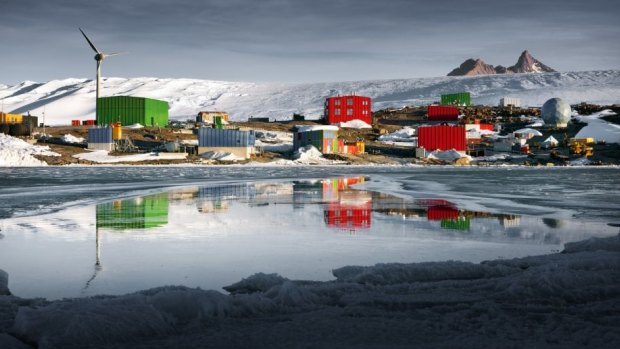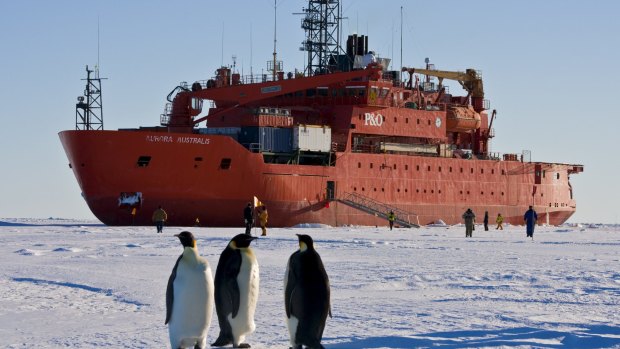By Anthony Bergin
We sometimes forget that we assert sovereignty over 42 per cent of the Antarctic continent, roughly the size of mainland Australia minus Queensland.
So the Turnbull government's Antarctic strategy and 20-year action plan released this week is important. It responds to the essential elements of a report to the federal government nearly two years ago by Tony Press, a former director of the Australian Antarctic Division.
Press found the pre-eminence we've traditionally held because of our historic polar connections and scientific and diplomatic leadership can no longer be assumed.
If we're not a big player in Antarctic affairs then our polar agenda will be driven by others. There's now, for example, a risk of being left behind by China. China's setting up its first air squadron in Antarctica this year. Last year it announced it was preparing to build a fifth research station on the continent.

Mawson research station at Horseshoe Harbour.Credit: Christopher Wilson
China's building a second icebreaker ship and has made it clear to domestic audiences that possible resource development is its interest in the region. It's expanding its fishing for krill in the Southern Ocean, the largest unexploited fishery in the world.
So, does the government's new Antarctic blueprint provide a useful framework to understand what we must do in the frozen continent or is it just a snow job?
On balance, the strategy and action plan offers a strong framework to strengthen our polar efforts and sets out clear priorities to guide the allocation of scarce resources.
For the first time, we've spelled out our strategic Antarctic interests. The document correctly recognises that science is the currency of our Antarctic influence and maps out a commitment to strengthening national and international collaboration in Antarctic science programs.

A new icebreaker will replace the ageing Aurora Australis.Credit: Mike Zupanc, Australian Antarctic Division
The strategy's right to give priority to building an overland traverse capability: other nations' deep-field logistic capabilities allow them to visit parts of our territory that we've never seen and can't get to (they give them their own place names). We need better platforms to search for the holy grail of climate science, the million-year-plus ice core.
The unity of direction is expressed in a handful of themes in the strategy: establishing science leadership, strengthening the Antarctic treaty system, protecting the environment and fostering economic opportunities.
While it's helpful to have an explanation of how we will marshal our resources when the continent's facing much greater geopolitical contestation, there's no attention given to the role of diplomacy if we're to lift our influence.
That's critical if we're to be an Antarctic leader, not a follower. Australian diplomats were pivotal players in negotiating the Antarctic treaty, and along with France led the development of the Madrid Protocol on banning Antarctic mining.
A critical step for our Antarctic future is the firm commitment to constructing a new icebreaker to replace the ageing Aurora Australis.
On Thursday the government signed a contract for Australia's new icebreaker, amounting to a $1.9 billion investment, with $529 million being invested in the capital cost of the icebreaker, and $1.38 billion to be spent on operations and maintenance during its 30-year lifespan.The custom-built ship from Dutch company Damen Schelde, built in Romania, is due to arrive in Australia in mid-2020.The vessel will give us 200 ship days a year, compared with our current 180 days
But we need a more whole-of-government approach so that we get the most from our investment: even though it's a specialised vessel, the replacement for Aurora Australis should be considered for other uses when not engaged in our Antarctic program.
It's positive that the strategy points out Defence will establish regular flights to Antarctica. But the ADF should be much more involved in our programs on the ice.
There's increased scope for future unmanned aerial vehicles and P-8A Poseidon maritime surveillance and response aircraft. Such military support wouldn't violate the "peaceful purposes" provision in the Antarctic treaty and would allow us to project our southern national interests through the ADF.
The new plan is silent on response assets: in responding to incidents that might arise down south we need a surface vessel. Neither the Customs' Cape-class nor navy's likely Armidale-class replacement vessels are suited for operations in the Southern Ocean.
We need an ice-strengthened, capable seagoing platform in the context of acquiring patrol vessels capable of more-extended operations than our Armidale-class patrol boats.
The strategy talks about being a logistics collaborator of choice in east Antarctica. But it fails to acknowledge the importance of our search and rescue responsibilities. As we, and other Antarctic nations, enhance their polar programs, with more personnel and greater coverage of land and marine activities, the risk of SAR incidences will increase in this harsh environment.
The strategy sensibly focuses on the importance of our work in the east Antarctic region. That's congruent with our core interest of sovereignty over our Antarctic territory. But we should avoid any perception that we're focused only on those waters surrounding our sub-Antarctic territories and our Antarctic territory.
Where to from here? If we're fair dinkum about pursuing our Antarctic interests, we need to be active in Antarctica. But our present capability means we can't match what others are doing in our territory, let alone lead.
So our Antarctic budget needs to reflect our aspirations in Antarctica: we won't have an Antarctic strategy unless we commit the resources. This should be seen as a whole-of-government responsibility, not just the responsibility of the Department of Environment. On Wednesday the government committed about $200 million in additional resources during 10 years to our polar work, including $55 million dollars to re-establish our over-ice traverse capability such as tractors, sleds, mobile inland research stations and new core drills. It's not rivers of gold, but it's a good result in terms of sustainable funding.
Greater investment in Antarctica will return huge dividends to Australia, not just diplomatic influence, but in scientific knowledge that's key for this country's future.
But our new Antarctic strategy and 20-year action plan won't do all that just by its release; even the best strategy is worthless unless it's well implemented.
Anthony Bergin is deputy director of the Australian Strategic Policy Institute and co-author of Frozen Assets: Securing Australia's Antarctic Future.